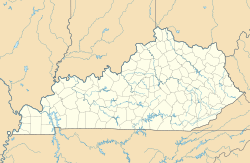Ogle, Kentucky facts for kids
Quick facts for kids
Ogle, Kentucky
|
|
|---|---|
| Country | United States |
| State | Kentucky |
| County | Clay |
| Elevation | 994 ft (303 m) |
| Time zone | UTC-5 (Eastern (EST)) |
| • Summer (DST) | UTC-4 (EDT) |
| Area code(s) | 606 |
| GNIS feature ID | 514310 |
Ogle is a small place in Clay County, Kentucky, in the United States. It is known as an unincorporated community. This means it's a group of homes and people living together, but it doesn't have its own official city government or mayor. You can find Ogle on Otter Creek Road. It's about 9 miles (14 km) south of a bigger town called Manchester.
Contents
Understanding Ogle's Location
Ogle is located in the eastern part of Kentucky. It sits in Clay County, which is known for its beautiful natural areas. The community is found along Otter Creek Road. This road helps connect Ogle to nearby areas.
What is an Unincorporated Community?
An unincorporated community like Ogle is a place where people live. However, it is not officially recognized as a city or town. This means it does not have its own local government. Instead, it is governed by the larger county it is in. For Ogle, that is Clay County.
History and Name of Ogle
The history of Ogle is quite interesting. It shows how communities grow and change over time. The name "Ogle" itself has a bit of a mystery.
When Did Ogle Get Its Name?
The exact reason for the name "Ogle" is not known. Sometimes, places are named after people or local features. But for Ogle, the origin of its name remains a secret.
Ogle's Post Office History
A post office was opened in Ogle in April 1893. This was an important step for the community. It meant people could send and receive mail right there. The first person to run the post office was Morris Jackson. He was known as the first postmaster of Ogle.
Ogle in the Past
Ogle did not appear on the 1900 census. A census is an official count of a population. Instead, people living in the area were listed as living in "Otter Creek." This suggests that the area was known by a different name back then. It also shows how communities can change their names or how they are officially recorded over time.


